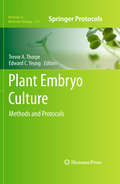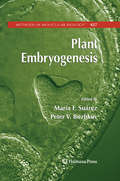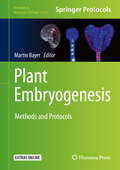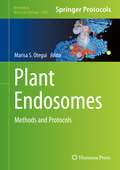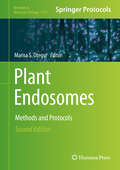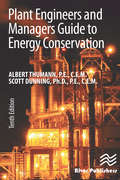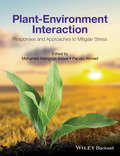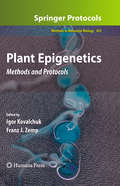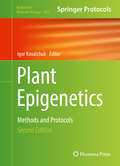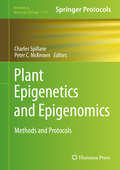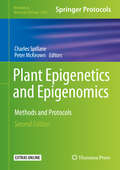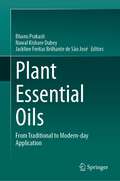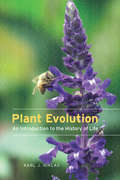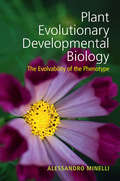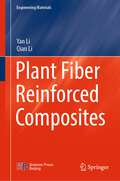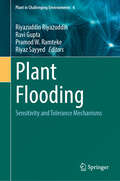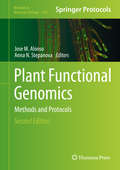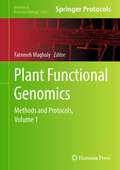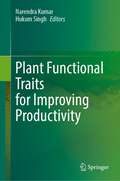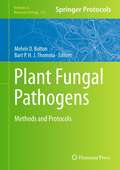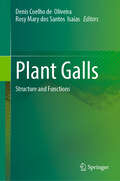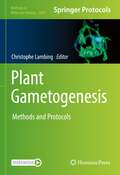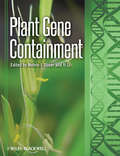- Table View
- List View
Plant Embryo Culture
by Trevor A. Thorpe Edward C. YeungA great fascination for biologists, the study of embryo development provides indispensable information concerning the origins of the various forms and structures that make up an organism, and our ever-increasing knowledge gained through the study of plant embryology promises to lead to the development of numerous useful applications. In Plant Embryo Culture: Methods and Protocols, expert researchers from the field provide a ready source of information for culturing zygotic embryos for different types of studies, both theoretical and practical. The book's main sections examine a wide range of related topics, including the culture of zygotic embryos for developmental studies, the application of embryo culture techniques focusing on embryo rescue methods, cryopreservation of zygotic embryos, the use of zygotic embryos as explants for somatic embryogenesis and organogenesis, as well as transformation protocols using zygotic embryos as starting material. Written in the highly successful Methods in Molecular BiologyTM series format, the detailed chapters include introductions to their respective topics, lists of the necessary materials and reagents, step-by-step, readily reproducible laboratory protocols, and vital notes on troubleshooting and avoiding known pitfalls. Authoritative and convenient, Plant Embryo Culture: Methods and Protocols serves as a key reference that can be used by scientists of all backgrounds to help develop their own customized methods for many different species and for a variety of purposes.
Plant Embryogenesis
by Peter V. Bozhkov Maria Fernanda SuarezStep-by-step reproducible laboratory procedures written by the top experts in the field offering their time-tested hints, tricks, and tips. Presents detailed outlines of embryonic systems models along with cutting-edge cellular, genetic, and molecular mechanism. Provides the most comprehensive collection of protocols on plan embryo development.
Plant Embryogenesis: Methods and Protocols (Methods in Molecular Biology #2122)
by Martin BayerThis volume details state-of-the-art methods for the study of plant embryogenesis in the model organism Arabidopsis thaliana, other models, and non-model species. Chapters guide readers through genetic screens, phenotypic analysis, live imaging, transcriptional profiling, methods on other model and non-model species beyond Arabidopsis thaliana, and introduction to systems that allow to culture or produce zygotic and somatic embryos in vitro. Written in the highly successful Methods in Molecular Biology series format, chapters include introductions to their respective topics, lists of the necessary materials and reagents, step-by-step, readily reproducible laboratory protocols, and tips on troubleshooting and avoiding known pitfalls. Authoritative and cutting-edge, Plant Embryogenesis: Methods and Protocols aims to ensure successful results in the further study of this vital field.
Plant Endosomes
by Marisa S. OteguiPlant Endosomes: Methods and Protocols explores a collection of protocols and techniques to analyze in vivo trafficking of endocytic/endosomal cargo, including lipids, fluids, proteins and ligands, ultrastructural features of endosomes by high-pressure freezing/freeze-substitution and electron tomography, as well as protein-protein interactions in the endosomal and endomembrane system. The volume continues with coverage of the sorting defects in the transport of vacuolar storage proteins, function conservation of plant endosomal proteins, endosomal trafficking during plant responses to pathogens, protein composition of endosomes and endocytic vesicles, ubiquitination of endosomal cargo proteins and the identification of novel endosomal components by chemical genomics and proteomics. Written in the highly successful Methods in Molecular Biology series format, chapters include introductions to their respective topics, lists of the necessary materials and reagents, step-by-step, readily reproducible laboratory protocols and tips on troubleshooting and avoiding known pitfalls. Detailed and practical, Plant Endosomes: Methods and Protocols gathers contributions from many leading and emerging plant membrane trafficking researchers in order to promote and facilitate novel studies and ideas in this vital field.
Plant Endosomes: Methods and Protocols (Methods in Molecular Biology #2177)
by Marisa S. OteguiThis second edition details techniques for the study of cargo trafficking through endosomes. New and updated chapters guide readers through methods and protocols on the structural aspects of plant endosomes, combined biochemical, omics, imaging approaches to study the dynamics and contents of endosomal compartments. Additional chapters are dedicated to the analysis of lipids on endosomes and the identification and analysis of lipid binding proteins and lipid-binding domains relevant for the study of plant endosomes. Written in the highly successful Methods in Molecular Biology series format, chapters include introductions to their respective topics, lists of the necessary materials and reagents, step-by-step, readily reproducible laboratory protocols, and tips on troubleshooting and avoiding known pitfalls. Authoritative and cutting-edge, Plant Endosomes: Methods and Protocols, Second Edition aims to ensure successful results in the further study of this vital field.
Plant Engineers and Managers Guide to Energy Conservation
by Albert Thumann Scott C. DunningCompletely revised and updated, this tenth edition of a bestseller covers both management and technical strategies for slashing energy costs by as much as 40 percent in industrial facilities. It discusses cogeneration, gas distributed generation technologies, steam system optimization, geothermal heat pumps, energy outsourcing, electricity purchasing strategies, and power quality case studies. It also provides guidelines for life cycle costing, electrical system optimization, lighting and HVAC system efficiency improvement, mechanical and process system performance, building energy loss reduction, financing energy projects, and more.
Plant Environment Interaction
by Parvaiz Ahmad Mohamed Mahgoub AzoozThe increase in global population, urbanization and industrialization is resulting in the conversion of cultivated land into wasteland. Providing food from these limited resources to an ever-increasing population is one of the biggest challenges that present agriculturalists and plant scientists are facing. Environmental stresses make this situation even graver. Plants on which mankind is directly or indirectly dependent exhibit various mechanisms for their survival. Adaptability of the plants to changing environment is a matter of concern for plant biologists trying to reach the goal of food security. Despite the induction of several tolerance mechanisms, sensitive plants often fail to withstand these environmental extremes. Using new technological approaches has become essential and imperative. Plant-Environment Interaction: Responses and Approaches to Mitigate Stress throws light on the changing environment and the sustainability of plants under these conditions. It contains the most up-to-date research and comprehensive detailed discussions in plant physiology, climate change, agronomy and forestry, sometimes from a molecular point of view, to convey in-depth understanding of the effects of environmental stress in plants, their responses to the environment, how to mitigate the negative effects and improve yield under stress. This edited volume is written by expert plant biologists from around the world, providing invaluable knowledge to graduate and undergraduate students in plant biochemistry, food chemistry, plant physiology, molecular biology, plant biotechnology, and environmental sciences. This book updates scientists and researchers with the very latest information and sustainable methods used for stress tolerance, which will also be of considerable interest to plant based companies and institutions concerned with the campaign of food security.
Plant Epigenetics
by Igor Kovalchuk Franz J. ZempThe past fifteen years have witnessed major advances in epigenetics, one of the most popular and quickly evolving fields of modern science. In Plant Epigenetics: Methods and Protocols, expert researchers explore the most recent developments, examining in great detail the contribution of epigenetic regulation to cell function in plants. Chapters include a variety of protocols for studying the function of small non-coding RNAs, DNA methylation, and histone modifications in plants, often in different degrees of complexity. This volume describes bioinformatic approaches to the analysis of high-throughput data, such as bisulfite sequencing and Chip-on-chip assays. It features much-desired protocols for plant transgenesis and the analysis of genome stability, with a detailed discussion of their applications to epigenetic studies. Composed in the highly successful Methods in Molecular BiologyTM series format, each chapter contains a brief introduction, step-by-step methods, a list of necessary materials, and a Notes section which shares tips on troubleshooting and avoiding known pitfalls. Wide-ranging and innovative, Plant Epigenetics: Methods and Protocols is an invaluable manual designed to help researchers uncover the undiscovered and unexplained phenomena in plant biology.
Plant Epigenetics
by Igor KovalchukThe discovery of DNA as the genetic material brought great hope to scientists all over the world. It was believed that many of the lingering questions in genetics and the mechanisms of heredity would fnally be answered. However, as often is the case in science, more qu- tions arose out of this discovery. What defnes a gene? What are the mechanisms of gene regulation? Further discovery and technological innovations brought about sequencing techniques that allowed the study of complete genomes from many organisms, including Arabidopsis and humans. Despite all the excitement surrounding these technologies, many features of the genome remained unclear. Peculiar characteristics in genome composition such as signifcant redundancy consisting of many repetitive elements and noncoding sequences, active transcriptional units with no protein product, and unusual sequences in promoter regions added to the mysteries of genetic make-up and gene regulation. Indeed, the more we discovered about the genome, the more diffcult it became to understand the complexity of cellular function and regulation. Out of the study of the intricacies of the genome and gene regulation, arose a new science that was independent of actual DNA changes, but critical in maintaining gene regulation and genetic stability. Epigenetics, literally translated as "above genetics," is the science that describes the mechanisms of heritable changes in gene regulation that does not involve modifcations of DNA sequence. These changes may last through somatic cell division and, in some cases, throughout multiple generations.
Plant Epigenetics and Epigenomics
by Charles Spillane Peter C. MckeownMany fundamental discoveries concerning epigenetics and the elucidation of mechanisms of epigenetic regulation have developed from studies performed in plants. In" Plant Epigenetics and Epigenomics: Methods and Protocols," leading scientists in the epigenetics field describe comprehensive techniques that have been developed to understand the plant epigenetic landscape. These include recently developed methods and techniques for analysis of epigenetically regulated traits, such as flowering time, transposon activation, genomic imprinting and genome dosage effects. Written in the highly successful "Methods in Molecular Biology" series format, chapters include introductions to their respective topics, lists of the necessary materials and reagents, step-by-step, readily reproducible laboratory protocols, and key tips on troubleshooting and avoidance of known pitfalls. Authoritative and practical, "Plant Epigenetics and Epigenomics: Methods and Protocols "seek to aid scientists in the further study of plant epigenetic phenomena using advanced contemporary methods. "
Plant Epigenetics and Epigenomics: Methods and Protocols (Methods in Molecular Biology #2093)
by Charles Spillane Peter McKeownThis second edition volume expands on the previous edition with a look at the latest techniques in plant epigenetics and epigenomic research. Chapters in this book cover topics such as whole genome methylome analysis; analysis of DNA methylation; chromatin analysis of metabolic gene clusters in plants; plant epigenetic stress memory induced by drought; small non-coding RNA analysis in seeds of forest tree species; and a discussion on epigenetics inheritance in plants. Written in the highly successful Methods in Molecular Biology series format, chapters include introductions to their respective topics, lists of the necessary materials and reagents, step-by-step, readily reproducible laboratory protocols, and tips on troubleshooting and avoiding known pitfalls. Cutting-edge and comprehensive, Plant Epigenetics and Epigenomics: Methods and Protocols, Second Edition is a valuable resource for both novice and expert researchers, and aims to advance this field of study by paving the way for integrating epigenetic mechanisms into models of plant function during development and evolution.
Plant Essential Oils: From Traditional to Modern-day Application
by Nawal Kishore Dubey Bhanu Prakash Jackline Freitas Brilhante de São JoséThis book is a comprehensive collection of information on essential oils and their industrial application. It provides reader with a systematic and advanced knowledge of the role of essential oils as natural preservatives and therapeutic agents. Food and pharmaceuticals are two important pillars of human civilization. Plant essential oils and their volatile compounds have been used for preservation as well as for the treatment of human illness for long as traditional practices in biodiversity-rich countries. This book deals with the potential uses of essential oils against insect pests and spoilage microbes of agri-food commodities such as pulses, cereal, fruits, and their shelved products. It also highlights the molecular-assisted engineering of plant essential oils, the pharma-kinetic facet, and their potential in pharmaceutical and aromatherapy. In addition, the book covers recent advances in science and technology such as extraction methods, metabolomics, phytochemical genomics, bioinformatics, conformational dynamics, mathematical modeling, and nanotechnology application. This book is of interest to teachers, researchers, food scientists, capacity builders, and policymakers. Also, it serves as an additional reading material for undergraduate and postgraduate students of agriculture, food, and pharmaceutical sciences.
Plant Evolution: An Introduction to the History of Life
by Karl J. NiklasAlthough plants comprise more than 90% of all visible life, and land plants and algae collectively make up the most morphologically, physiologically, and ecologically diverse group of organisms on earth, books on evolution instead tend to focus on animals. This organismal bias has led to an incomplete and often erroneous understanding of evolutionary theory. Because plants grow and reproduce differently than animals, they have evolved differently, and generally accepted evolutionary views—as, for example, the standard models of speciation—often fail to hold when applied to them. Tapping such wide-ranging topics as genetics, gene regulatory networks, phenotype mapping, and multicellularity, as well as paleobotany, Karl J. Niklas’s Plant Evolution offers fresh insight into these differences. Following up on his landmark book The Evolutionary Biology of Plants—in which he drew on cutting-edge computer simulations that used plants as models to illuminate key evolutionary theories—Niklas incorporates data from more than a decade of new research in the flourishing field of molecular biology, conveying not only why the study of evolution is so important, but also why the study of plants is essential to our understanding of evolutionary processes. Niklas shows us that investigating the intricacies of plant development, the diversification of early vascular land plants, and larger patterns in plant evolution is not just a botanical pursuit: it is vital to our comprehension of the history of all life on this green planet.
Plant Evolutionary Developmental Biology: The Evolvability of the Phenotype
by Alessandro Minelli Maria Pia MannucciCompared to animals, plants have been largely neglected in evolutionary developmental biology. Mainstream research has focused on developmental genetics, while a rich body of knowledge in comparative morphology is still to be exploited. No integrated account is available. <P><P>In this volume, Minelli fills this gap using the same approach he gave to animals, revisiting traditional concepts and providing an articulated analysis of genetic and molecular data. Topics covered include leaf complexity and the evolution of flower organs, handedness, branching patterns, flower symmetry and synorganization, and less conventional topics such as fractal patterns of plant organization. Also discussed is the hitherto neglected topic of the evolvability of temporal phenotypes like a plant's annual, biennial or perennial life cycle, flowering time and the timing of abscission of flower organs. This will be informative reading for anyone in the field of plant evo-devo, from students to lecturers and researchers.
Plant Fiber Reinforced Composites (Engineering Materials)
by Yan Li Qian LiThis book comprehensively and systematically introduces the microstructure characteristics of plant fibers and the manufacturing process, interface characteristics, mechanical behaviors and physical properties of plant fiber reinforced composites, as well as their engineering demonstration applications. Plant fibers derived from natural resources have been thrust into the global spotlight as environment-friendly materials with attractive advantages of renewability, biodegradability, high specific strength and modulus and good sound absorption and heat insulation performance, and have become promising alternative to traditional synthetic fibers in making fiber-reinforced composites with structure-function integration. This book combines the basic theory with engineering applications for highlighting the unique research method for plant fiber reinforced composites with hierarchical structure. It is intended for undergraduate and graduate students who are interested in natural fiber composites, and scientific researchers and engineers looking to develop the design and manufacture of green composites in the fields of aerospace, railway transportation vehicles, automotive engineering and civil infrastructures.
Plant Flooding: Sensitivity and Tolerance Mechanisms (Plant in Challenging Environments #6)
by Ravi Gupta Pramod W. Ramteke Riyaz Sayyed Riyazuddin RiyazuddinThe issue of flooding has become a significant challenge on a global scale especially in rain-fed ecosystems, having soils with poor drainage. This significantly diminishes crop yield. Therefore, it is imperative to address the issue of flood stress, including the potential strategies for mitigating its adverse effects on crop yield, in order to ensure the continued provision of food for the growing global population. This book aims at bringing out a comprehensive collection of information on flooding stress on plants such as morphological, physiological, and molecular responses of plants to flood stress, omics studies to understand the molecular mechanism underlying flooding stress tolerance, and transgenic and microbial strategies to overcome flood stress. It also deals with the use of new technologies to understand flood stress and plant responses. The chapters included in this book are the compilation of latest information and data on the flood stress, its effect on the physiology, growth, and development of crop plants as well as mechanisms adapted by plants to overcome this stress. This book will help Researchers, Professors, Agri-Entrepreneurs, and Technologists understand the detrimental effects of flood stress, to develop newer approaches to mitigate flood stress. The book will help fill in designing new dimensions in the Flood Stress research and development of methods and technologies to overcome the flood-induced losses in crop yield.
Plant Functional Genomics
by Jose M. Alonso Anna N. StepanovaThis second edition volume discusses the revolutionary development of faster and less expensive DNA sequencing technologies from the past 10 years and focuses on general technologies that can be utilized by a wide array of plant biologists to address specific questions in their favorite model systems. This book is organized into five parts. Part I examines the tools and methods required for identifying epigenetic and conformational changes at the whole-genome level. Part II presents approaches used to determine key aspects of a gene's function, such as techniques used to identify and characterize gene regulatory networks. This is followed by a discussion of tools used to analyze the levels of mRNA, mRNA translation rates and metabolites. Part III features a compilation of forward and reverse genetic approaches that include recent implementation of high-throughput sequencing in classical methodologies such as QTL mapping. The final two parts explore strategies to facilitate and accelerate the generation and testing of functional DNA elements and basic computational tools used to facilitate the use of systems biology approached by a broad spectrum of plant researchers. Written in the highly successful Methods of Molecular Biology series format, chapters include introductions to their respective topics, lists of the necessary materials and reagents, step-by-step, readily reproducible laboratory protocols and key tips on troubleshooting and avoiding known pitfalls. Practical and timely, Plant Functional Genomics: Methods and Protocols, Second Edition highlights the latest developments in DNA sequencing technologies that are likely to continue shaping the future of functional genomics.
Plant Functional Genomics
by Erich GrotewoldErich Grotewold has assembled a team of leading plant scientists to describe in detail the most commonly used methods for investigating plant gene function in a wide variety of plants, during plant pathogen interactions, and even in algae. These readily reproducible protocols include computational, molecular, and genetic methodologies designed for both general and specific problems. Here the reader will learn about powerful computational and statistical tools to help predict gene function either on the basis of comparative genomics, or from the analysis of complex genome sequences. Numerous loss-of-function and gain-of-function techniques for discovering gene function are presented in step-by-step detail.
Plant Functional Genomics: Methods and Protocols, Volume 1 (Methods in Molecular Biology #2787)
by Fatemeh MaghulyThis detailed book gathers hands-on techniques to characterize, identify, localize, profile, and determine genome functions in plants. Volume 1 opens with a section exploring protocols to advance our understanding of plant genetics and ecology via phenomics, and it continues with chapters on plant genetics, transcriptomics, and proteomics to unravel plant protein structures and functions, bridging proteomics and phosphoproteomics. Written for the highly successful Methods in Molecular Biology series, chapters include introductions to their respective topics, lists of the necessary materials and reagents, step-by-step and readily reproducible laboratory protocols, and tips on troubleshooting and avoiding known pitfalls. Authoritative and comprehensive, Plant Functional Genomics: Methods and Protocols serves as an ideal guide to the immense promise of functional genomics, spanning from fundamental evolutionary studies to practical advancements in crop improvement.
Plant Functional Genomics: Methods and Protocols, Volume 2 (Methods in Molecular Biology #2788)
by Fatemeh MaghulyThis detailed book gathers hands-on techniques to characterize, identify, localize, profile, and determine genome functions in plants. Volume 2 opens with metabolomic methods that uncover chemical intricacies, exploring glycome mixtures, cell wall components, and computational metabolomics, and it continues with sections on plant genome validation, computational approaches and bioinformatic tools, and case studies exploring the biological effects of magnetic fields and the study of cyanobacteria. Written for the highly successful Methods in Molecular Biology series, chapters include introductions to their respective topics, lists of the necessary materials and reagents, step-by-step and readily reproducible laboratory protocols, and tips on troubleshooting and avoiding known pitfalls. Authoritative and comprehensive, Plant Functional Genomics: Methods and Protocols serves as an ideal guide to the immense promise of functional genomics, spanning from fundamental evolutionary studies to practical advancements in crop improvement.
Plant Functional Traits for Improving Productivity
by Narendra Kumar Hukum SinghThis book discusses how plant functional trait selection can help researchers to understand the plant-environment relationship, identify desirable traits, modulate plant resilience according to the changing climate, optimize resource use efficiency, and enhance genetic improvement. The plant functional traits-based approach provides a framework for improving crop productivity in agricultural systems with high precision. It enables researchers to develop crop varieties with desirable traits by focusing on the fundamental characteristics influencing growth, development, and response. Climate change and environmental variability pose significant agricultural challenges. The plant functional traits-based approach can help address these challenges by selecting and breeding traits that enhance resilience and adaptability capacity of the plant. This approach also contributes to sustainable agriculture, by focusing on increased food production, and resilience in extreme environmental conditions. This book provides guidance to the researchers and breeders to develop crop varieties with desirable traits. It is also a reference book for graduate and postgraduate students studying botany and agriculture.
Plant Fungal Pathogens
by Melvin D. Bolton Bart P.H.J. ThommaOver the course of evolution, fungi have adapted to occupy specific niches, from symbiotically inhabiting the flora of the intestinal tract of mammals to saprophytic growth on leaf litter resting on the forest floor. In Plant Fungal Pathogens: Methods and Protocols, expert researchers in the field detail many of the methods which are now commonly used to study fungal plant pathogens. These include methods and techniques for model systems such as Arabidopsis thaliana as well as crop plants, aspects of fungal biology, genome annotation, next-generation sequencing, and fungal transformation and molecular tools for disease and/or pathogen quantification that are critical for revealing the role for a fungal gene of interest in disease development. Written in the highly successful Methods in Molecular BiologyTM series format, chapters include introductions to their respective topics, lists of the necessary materials and reagents, step-by-step, readily reproducible laboratory protocols, and key tips on troubleshooting and avoiding known pitfalls. Authoritative and practical, Plant Fungal Pathogens: Methods and Protocols seeks to aid scientists in the further study in current techniques that cover a wide-range of methods to study molecular aspects of pathogenesis.
Plant Galls: Structure and Functions
by Denis Coelho de Oliveira Rosy Mary dos Santos IsaiasThis book provides topics on gall development, chemistry, and physiology focusing on galls from different parts of the world. The chapters are devoted to get together basic knowledge and novelties on plant responses to the stimuli of diverse gall inducers, on cell, tissue, and organism levels. The information contained in this volume will set lights on crucial points that together explain how the plant-gall inducer interactions establish and are successful in different natural environments.
Plant Gametogenesis: Methods and Protocols (Methods in Molecular Biology #2484)
by Christophe LambingThis volume provides protocols and methods on techniques to study plant gametogenesis. Chapters are divided into four sections covering omics, cytological, molecular approaches, plant transformation, genome editing, bioinformatics, and data analysis. Written in the format of the highly successful Methods in Molecular Biology series, each chapter includes an introduction to the topic, lists necessary materials and reagents, includes tips on troubleshooting and known pitfalls, and step-by-step, readily reproducible protocols. Authoritative and cutting-edge, Plant Gametogenesis: Methods and Protocols aims to be a foundation for future studies and to be a source of inspiration for new investigations in the field.
Plant Gene Containment
by Melvin J. Oliver Yi LiGene Containment provides a comprehensive look at genetically modified organisms and the strategies and implementation of key methods to gene containment. The book is divided into 5 parts: An Introduction that discusses the need for biotechnology and GMOs, Section 1 looks at the need for gene containment, Part II discusses varying strategies for gene containment, section III explores the assessment of gene containment approaches, and section IV covers the steps involved in implementing gene containment. Gene Containment will provide a thorough and up to date look at gene containment research and the needs for implementing new strategies in this arena.
